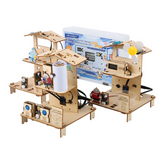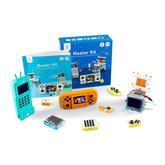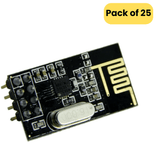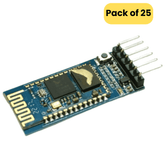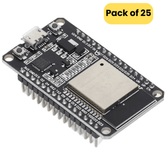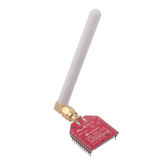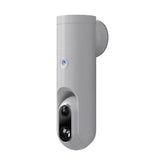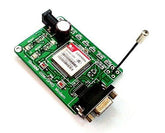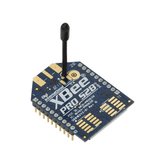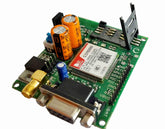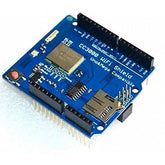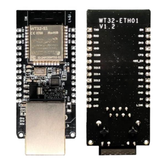-
SimCom SIM900A GSM Module with SMA AntennaSimCom SIM900A GSM Module with SMA Antenna The SIM900A Modem is a wireless module manufactured by SIMCOM. It is a Dual Band GSM modem operating on the 900MHz frequencies. The modem has the capability to automatically search for these two bands. Additionally, users can...
- Rs. 1,653
Rs. 1,895- Rs. 1,653
- Unit price
- per
Save Rs. 242 -
Sim 800C GSM Modem with BatterySim 800C GSM Modem with Battery The SIM800C GSM Modem with Battery is a versatile and powerful modem that can be used for a variety of applications, including data and SMS. It is compatible with a wide range of networks and features a built-in...
- Rs. 1,296
Rs. 1,446- Rs. 1,296
- Unit price
- per
Save Rs. 150 -
Elecrow LR1302 LoRaWAN Gateway Module SPI EU868 SX1302 Long Range Gateway Module Support 8 ChannelsElecrow LR1302 LoRaWAN Gateway Module SPI EU868 SX1302 Long Range Gateway Module Support 8 Channels The Elecrow LR1302 LoRaWAN® Gateway Module is a next-generation long-range communication solution designed for high-performance IoT networks. Built on the powerful Semtech SX1302 LoRaWAN® baseband chip, it delivers improved...
- Rs. 2,954
Rs. 3,999- Rs. 2,954
- Unit price
- per
Save Rs. 1,045 -
NRF24L01 Ultra Low Power 2.4GHz RF Wireless Transceiver ( Pack of 25)NRF24L01 Ultra-Low Power 2.4GHz RF Wireless Transceiver The NRF24L01 2.4GHz Antenna Wireless Transceiver Module is a compact and integrated IC designed for ultra-low power (ULP) RF transmission and reception in the 2.4GHz ISM band. It boasts a peak current of less than 14mA for...
- Rs. 1,799
Rs. 2,450- Rs. 1,799
- Unit price
- per
Save Rs. 651 -
HC-05 Bluetooth Module ( Pack of 25)HC-05 Bluetooth Module A well-liked module like the HC-05 Bluetooth can give your projects two-way (full-duplex) wireless connectivity. With the help of HC-05, you can connect with any Bluetooth-enabled device, such as a phone or laptop, or with two microcontrollers like an Arduino, Node...
- Rs. 6,599
Rs. 8,999- Rs. 6,599
- Unit price
- per
Save Rs. 2,400 -
ESP32 Node MCU Development Board with Wifi and Bluetooth (CP2102 Driver, 30 PIN) (Pack of 25)ESP32 (CP2102 Driver, 30 Pin) WiFi + Bluetooth NodeMCU-32 Development Board) The is NodeMCU ESP 32 Development board. This ESP WROOM 32 is a powerful, generic WiFi and Bluetooth module that targets a wide variety of applications, ranging from low-power sensor networks to the most...
- Rs. 9,734
Rs. 12,425- Rs. 9,734
- Unit price
- per
Save Rs. 2,691 -
DRAGINO LORA BEE V1.1 + HOPERF RFM95-98(W)DRAGINO LORA BEE V1.1 + HOPERF RFM95-98(W) The Dragino Lora BEE is a LoRa module that allows the user to send data and provides ultra-long range spread spectrum communication and high interference immunity whilst minimizing current consumption. The LoRa BEE targets professional wireless sensor network...
- Rs. 2,189
Rs. 2,780- Rs. 2,189
- Unit price
- per
Save Rs. 591 -
Eyecloud AI CameraEyecloud AI Camera Eyecloud is an artificial intelligence company that specializes in creating top-notch security solutions by combining computer vision technology with embedded hardware. Their team has over 30 years of experience in complex image processing, optics, sensors, IQ tuning, CV algorithms, and camera...
- Rs. 14,999
Rs. 17,585- Rs. 14,999
- Unit price
- per
Save Rs. 2,586 -
SIM800A GSM-GPRS ModemSIM800A GSM/GPRS Serial & TTL Modem The SIM800A Quad-Band GSM/GPRS Module with RS232 Interface is a comprehensive solution for Quad-band GSM/GPRS communication, packaged in an LGA (Land Grid Array) format suitable for embedding in customer applications. The SIM800A module supports Quad-band operation across 850/900/1800/1900...
- Rs. 1,131
Rs. 1,280- Rs. 1,131
- Unit price
- per
Save Rs. 149 -
SIM900A GSM-GPRS ModemSIM900A GSM-GPRS Modem The SIM900A GSM-GPRS Modem is a small, low-cost, and easy-to-use module that provides GPRS/GSM communication with the use of a mobile SIM card. It operates on frequencies 900 and 1800MHz and allows users to receive/send mobile calls and SMS. The module...
- Rs. 1,361
Rs. 1,533- Rs. 1,361
- Unit price
- per
Save Rs. 172 -
13.56 MHz RFID Reader-Writer13.56 MHz RFID Reader/Writer This is 13.56 MHz RFID Tag. The RFID technology is used for sensing and identifying tagged people and objects for access control, automation, and a whole range of different applications. Designed to work on the industry-standard carrier frequency of 13.56 MHz...
- Rs. 2,358
Rs. 3,220- Rs. 2,358
- Unit price
- per
Save Rs. 862 -
XBee-PRO ZB S2B Extended Range ModuleXBee-PRO ZB S2B Extended Range Module XBee ZB PRO(a.k.a. Series 2) module improves upon the power output and data protocol of the Pro Series2. Series 2B modules allow you to create complex mesh networks based on the XBee ZB ZigBee mesh firmware. Series 2...
- Rs. 5,660
Rs. 6,526- Rs. 5,660
- Unit price
- per
Save Rs. 866 -
SIM800 GSM Modem module board with SMA AntennaSIM800 GSM Modem module board with SMA Antenna The SIM800 GSM Modem Module Board with SMA Antenna is a quad-band GSM/GPRS module that works on frequencies GSM 850MHz, EGSM 900MHz, DCS 1800MHz and PCS 1900MHz. SIM800 features GPRS multi-slot class 12/ class 10 (optional)...
- Rs. 1,315
Rs. 1,472- Rs. 1,315
- Unit price
- per
Save Rs. 157 -
RFID Reader SerialRFID Reader Serial The RFID Reader Module has an inbuilt antenna in minimized form factor. designed to work on the industry standard carrier frequency of 125 kHz. Sensitivity Range is about 6cm from antenna. Internal antenna on the PCB Buzzer to detect the proximity cards....
- Rs. 727
Rs. 861- Rs. 727
- Unit price
- per
Save Rs. 134 -
Arduino Uno CC3000 Wifi ShieldThis is a shield for the CC3000 WiFi Module. The CC3000 from TI (Texas Instruments) is a self-contained wireless network processor that makes incorporating internet connectivity into your project simple. Supply Voltage: 4.5V - 12V Host Interface: SPI @ 16MHZ Throughput (TCP): ~4Mbps IEEE...
- Rs. 3,548
Rs. 4,109- Rs. 3,548
- Unit price
- per
Save Rs. 561 -
Sim800 GSM-GPRS-Bluetooth ModemSim800 GSM-GPRS-Bluetooth Modem Sim800 Break out board has on Board Bluetooth Antenna and works same like sim900a with extra features like on board Bluetooth.(Bluetooth Firmware Needs to be Upgraded) On Board Power regulator, works on 9V 1A DC Power Switch, Reset Switch, Power LED...
- Rs. 1,167
Rs. 1,299- Rs. 1,167
- Unit price
- per
Save Rs. 132 -
WT32-ETH01 Embedded Serial Network Module – ESP32 WiFi + Bluetooth 2-in-1 Gateway with Ethernet PortWT32-ETH01 Embedded Serial Network Module – ESP32 WiFi + Bluetooth 2-in-1 Gateway with Ethernet Port The WT32-ETH01 Embedded Serial Network Module is a versatile gateway solution that integrates both Wi-Fi and Bluetooth functionalities using the powerful ESP32 chipset. Designed for reliable and efficient network...
- Rs. 1,553
Rs. 1,999- Rs. 1,553
- Unit price
- per
Save Rs. 446

Best Price Guarantee

Ready Stock for Bulk Purchase

Dedicated Account Managers

5% GST Benefits for Eligible SEZ and Edu

Technical Support Available

1-Year Manufacturer Warranty



